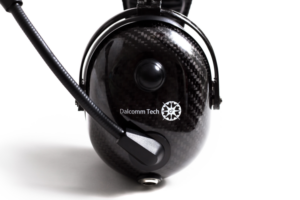What makes it miraculous?

Carbon fiber is, as Popular Mechanics says, “The Miracle Material”. No doubt you’ve seen many high end applications like the exceptionally expensive Lamborghini and other masterpiece concept cars. Carbon fiber has a number of impressive physical properties. It’s not just about its brilliant luster like the gemstone tiger’s eye, Boeing airliners are made with the stuff. In fact, carbon fiber turns out to be stronger than steel. It’s a whole lot lighter too. Other properties include resistance to fatigue and corrosion, non-toxicity to humans, a low coefficient of thermal expansion (it doesn’t expand as much as other things when it gets hot), it’s X-ray permeable and not flammable.
Why not use magnesium? Looking at a magnesium flame will cause permanent damage to your vision. In the event one’s aircraft was downed, if one was careful to look away while lighting such a headset on fire, it may be possible to use the headset as a flare. However, there exists no such possibility with a carbon fiber headset. It would have to suffice for one to look fashionable, with comfortably warm ears, while being rescued.
What about other ‘metal alloys’? Metal alloys are not bad. However, ‘metal alloys’ is a category and includes cheap waste metal mixes that are lightweight but very poor quality.
Why do we use carbon fiber in headsets?
The circum-aural headset is a headset with a cup around the ear. It was first made to solve the problem of communicating in a noisy environment. It also works out well for protecting your hearing. The original headsets issued to military and industrial uses were steel and plastic. That’s because the form of the headset followed it’s function. The headsets held up well but weren’t necessarily that comfortable or light. In fact, it is possible to still buy older brand headsets that continue to be made of steel and plastic and are still made in exactly the same form they were made in since the 1970’s.
Of course, the market is flooded with headsets just like them because, as the colloquial expression goes: ‘if it ain’t broke, don’t fix it’. Many have concluded that form must be considered. This is not only because they don’t like certain colors, and maybe prefer black for example, but also because they’re not on the front lines they’re just mowing their lawn and therefore care what they look like. As as result, there are lots of great looking lightweight options out there too.
The real thing?
There are headsets that look like they are made of carbon fiber but they are not in fact made of carbon fiber. Some use a process called hydrodipping to apply the image of carbon fiber. Some print it on by other means. Either way, such headsets pass off vastly inferior construction at nearly the same costs as the real thing. But, how can you tell the difference? Pick it up in your hands. A true carbon fiber headset is nearly half the weight of a traditional military headset. If you’ve been in the military or flown a plane with really old headsets in it and had to wear one of them for many hours you’ll know what an important difference the headset’s weight makes.
This is where Dalcomm Tech enters with a game changer. We believe that headsets should be not only superbly functional and protect your hearing, but also be exceptionally comfortable and simply, great looking. Thanks to this high tech, hand crafted material, carbon fiber, the ideal headset is a reality that you can own. To invoke an automotive metaphor, it’s not just the Cadillac of headsets, it’s the Lamborghini. We’re very happy to be the ones to make it available to you. Shop Now




 The Problem
The Problem







